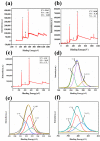Sensitive and Selective Detection of Clenbuterol in Meat Samples by a Graphene Quantum Dot Fluorescent Probe Based on Cationic-Etherified Starch
- PMID: 35215019
- PMCID: PMC8875664
- DOI: 10.3390/nano12040691
Sensitive and Selective Detection of Clenbuterol in Meat Samples by a Graphene Quantum Dot Fluorescent Probe Based on Cationic-Etherified Starch
Abstract
The use of clenbuterol (CLB) in large quantities in feedstuffs worldwide is illegal and potentially dangerous for human health. In this study, we directly prepared nitrogen-doped graphene quantum dots (N-GQDs) by a one-step method using cationic-etherified starch as raw material without pollution, which has the advantages of simple, green, and rapid synthesis of N-GQDs and high doping efficiency of nitrogen elements, compared with the traditional nitrogen doping method of reacting nitrogen source raw material with quantum dots. The N-GQDs synthesized by cationic etherification starch with different substitution degrees (DSs) exhibit good blue-green photoluminescence, good fluorescence stability, and water solubility. By comparing the fluorescence emission intensity of the two methods, the N-GQDs prepared by this method have higher fluorescence emission intensity and good fluorescence stability. Based on the static quenching mechanism between CLB and N-GQDs, a fluorescent probe was designed to detect CLB, which exhibited a wide linear range in the concentration range of 5 × 10-10~5 × 10-7 M (R2 = 0.9879) with a limit of detection (LOD) of 2.083 × 10-13 M. More excitingly, the N-GQDs fluorescent probe exhibited a satisfactory high selectivity. Meanwhile, it can be used for the detection of CLB in chicken and beef, and good recoveries were obtained. In summary, the strategic approach in this paper has potential applications in the detection of risky substances in the field of food safety.
Keywords: cationic-etherified starch; clenbuterol; fluorescence; fluorescence quenching; nitrogen-doped graphene quantum dots.
Conflict of interest statement
The authors declare that there are no conflicts of interest.
Figures







References
-
- Song C., Zhi A., Liu Q., Yang J., Jia G., Shervin J., Tang L., Hu X., Deng R., Xu C. Rapid and sensitive detection of β-agonists using a portable fluorescence biosensor based on fluorescent nanosilica and a lateral flow test strip. Biosens. Bioelectron. 2013;50:62–65. doi: 10.1016/j.bios.2013.06.022. - DOI - PubMed
-
- Li C., Wu Y.-L., Yang T., Zhang Y., Huang-Fu W.-G. Simultaneous determination of clenbuterol, salbutamol and ractopamine in milk by reversed-phase liquid chromatography tandem mass spectrometry with isotope dilution. J. Chromatogr. A. 2010;1217:7873–7877. doi: 10.1016/j.chroma.2010.10.055. - DOI - PubMed
Grants and funding
- 2020Y0019/Fujian Provincial Department of Science and Technology guiding Project
- 2020N5006/Industry-university Cooperation Project of Fujian Provincial Department of Science and Technology
- PMND202007/The Opening Project of Jiangxi Province Key Laboratory of Polymer Micro/Nano Manufacturing and Devices
- Minke Xing (2019) No.2/Fushimei agricultural and rural maker space
- 1/CX/CSRD VA/United States
LinkOut - more resources
Full Text Sources

